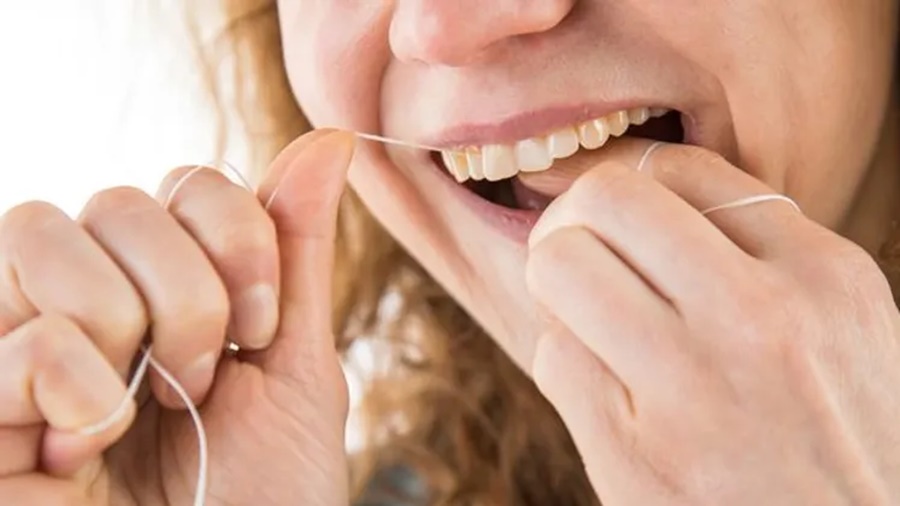Be careful with dental floss: cleaning between the teeth: we often do this wrong

Thoroughly brushing your teeth in the morning and evening is enough. Or? Unfortunately no, say dentists. The brushes cannot get to some places, but bacteria can.
Don’t forget to brush your teeth after eating – every child knows the saying. If Professor Dietmar Oesterreich has his way, this verse should be expanded to include a rhyme about the spaces between the teeth. So maybe like this: “Before the realm of dreams come the…” – well, you know.
The reason: “There are certain areas that a normal toothbrush cannot reach,” explains the Vice President of the German Dental Association. Weak points are everywhere where tooth follows tooth. In other words, in the small space in between, in which bacteria can settle and thus cause tooth decay and periodontitis. This applies even to the most beautiful set of teeth, in which the teeth are close together.
Clean between teeth in the evening
Dentist Professor Stefan Zimmer advocates cleaning the interdental spaces in the evening after brushing your teeth. “You don’t forget everything you do every day,” says the spokesman for the Information Center for Caries Prevention.
The fact that the saliva in the mouth contains antibacterial substances and thus counteracts the development of caries also speaks in favor of cleaning it in the evening. “During the night, the flow of saliva is lower and the protective mechanism is reduced,” explains Oesterreich. It is therefore all the more important that the teeth and the spaces between them are nice and clean when you sleep.
Use dental floss with care
The best-known tool for this is dental floss. According to Austria, using them is not rocket science. However, if used incorrectly, the gums can be affected.
“The goal when cleaning with dental floss is to slide along the curved tooth surfaces,” says the expert. “If you just rub back and forth, you hurt your gums.” He thinks the use of thin threads makes sense, especially for younger and middle-aged people. Especially in younger people, the gums lie tightly in the gap between the teeth.
In the opinion of the dentist, on the other hand, interdental brushes are usually more suitable for older people. “In the course of life, the gums recede a little, periodontitis is also more common, so that the spaces between the teeth are more open,” he says. The small brushes can clean there more effectively.
Dose force with interdental brushes
They are available in different sizes and shapes and from different suppliers. It is best for the treating dentist or a prophylaxis assistant to show you how to use it correctly. “The brush shouldn’t go through with too much pressure, but also not too easily,” says Oesterreich.
If you want to do it thoroughly, push the small brush into the gap between the teeth from both the outside and the inside. The device can be used several times, but as with the toothbrush, it is advisable to change it regularly.
What are interdental sticks?
Stefan Zimmer is in favor of interdental sticks. “It’s a kind of thin plastic toothpick covered in a layer of silicone with nubs.” These are available in different thicknesses.
The sticks can be rinsed off after use and reused. “They clean like dental floss, but are easier to use,” says Zimmer. The risk of injury is correspondingly lower.
Don’t use toothpaste
It is taboo to use toothpaste to clean the gaps. It contains abrasives. “If you then scrub too hard, you can actually brush away parts of the root of the tooth in between,” warns Zimmer.
His general advice is: “One should never work with great force. And if one feels resistance, one must not try to remove it by force.” It is better to ask your dentist whether and how this area should be cleaned.
interstitial caries in primary dentition
If a child already knows the rules for brushing teeth, you can start cleaning the spaces between them – right? Quite right, if you follow Stefan Zimmer. “You should start as soon as molars are in neighborly contact,” he advises. “Even in milk teeth there is caries in the interdental space.”
However, he sees it realistically: Very few parents clean the spaces between the teeth of their preschool children. “But you should try,” Zimmer encourages. Dental floss stretched on small holders can help to make this happen.
Decreasing fine motor skills in old age
Cleaning between the teeth is also a challenge for those in need of care because their fine motor skills no longer allow it. Practical support from relatives or nursing staff is therefore often necessary. “Seniors should take the time they need,” says Dietmar Oesterreich. “There are also holders for interdental toothbrushes that support fine motor skills.”
In any case, the effort is worth it: “Patients who care regularly have significantly fewer signs of inflammation,” is Austria’s experience. Older people in particular suffer from periodontitis. “This is the most common cause of tooth loss in old age, because teeth loosen due to bone loss as a result of periodontitis.”
“After a while, cleaning between the teeth becomes routine and even a necessity,” promises Austria. “And the best thing is when the dentist doesn’t have to act.”



